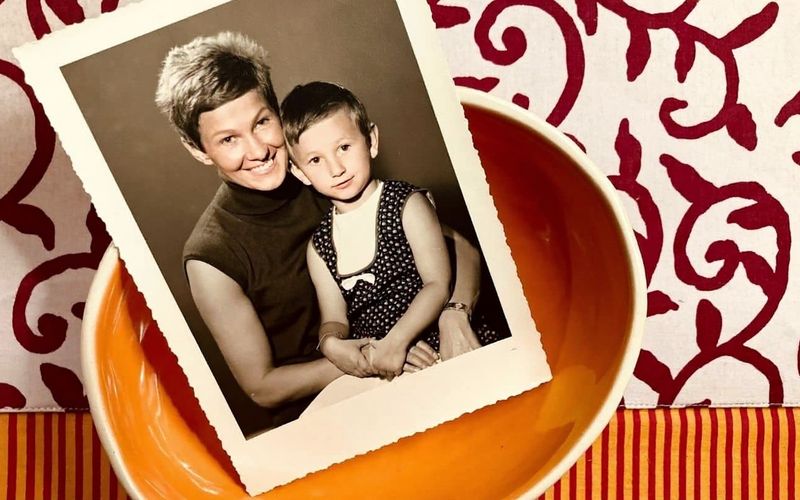When the bowl fell and broke into pieces, I felt shattered into pieces as well. The grief over this little broken object was shocking and completely inadequate. Yet it was real, and it was deep. Looking for answers, here’s what I found:
1. The Bowl Was a Symbol of Loss
It was one of three bowls that I had bought at the De Young Museum in San Francisco, decades ago. Industrial design, nothing precious, nothing unique. But the two years in San Francisco had been among my best years, embracing youth, freedom, optimism and adventure, filled with art and sunshine and innocent joy. The design and the joyful orange colour of the three bowls represented exactly that.
2. It Couldn’t Be Replaced
The breaking of one of the three became a symbol for something incomplete that would never feel whole again. Just like me, who, in the course of a rich and colorful life, had to leave dreams behind and face a reality that sometimes was almost unbearable. What I had lost couldn’t be brought back into life.
3. It Was a Symbol of Unresolved Grief
But there was more to it. My first emotion when looking at the broken pieces surprised me: It was linked to the grief over my mother’s death years ago. It had been dramatic: The vessel that had received, carried and brought my life into this world shattered into pieces by her own hand.
The guilt that I felt for failing to keep my mother from ending her life is the worst a daughter can experience. Just like the death of a child is for a parent.
Now, my mother had been gone for more than three or four years when the bowl broke. I had been to therapy after her death. And now, that broken little bowl reminded me that despite the years that had passed, the pain was still huge. It reminded me that I was still broken and far from feeling whole. Pain was lingering cruelly close to the surface, ready to break out any minute, without control.
4. The Bowl Became a Symbol for Healing
The broken bowl forced me to feel the pain once again, to cry and dive deep into my broken heart. But it held a golden opportunity as well: To experience grief with such force became my gateway towards healing. It became my “wound through which the light enters,” as Persian poet Rumi said.
I collected the broken pieces, even the porcelain dust. At first, I didn’t do anything with them. Months passed. Then, one day, I suddenly felt the urge to put the pieces together, a Herculean act. But I did it, and I found that it made me feel better. I had put the pieces together. Just as I had faced the abyss and somehow managed to conquer it. It did not destroy me. I was alive.
5. It Became a Symbol for Resilience
Again, years passed. The glued-together, not-so-good looking but somewhat complete little bowl sat in my China cabinet. I would never give it away or dispose of it, despite its deplorable looks. Then, I came across an article about the Art of Kintsugi and realized, that this is exactly what I had – instinctively – done: TSUGI meaning “connection,” KIN meaning “Gold.”
How to do it:
First, collect the pieces, then connect and glue them together. Finally, cover the cracks with precious gold. Kintsugi taught me to apply the finishing magic to my bowl: the GOLD.
The gold highlights the cracks instead of hiding them. It turned my bowl into a symbol of reconciliation with the past. My very own hard-earned symbol of resilience.
6. It Became a Symbol for Empowerment
It may not be the most beautiful, but certainly is the most precious, UNIQUE and beloved bowl in my household. This bowl tells my story. It is a witness to my strong will to carry on, to overcome death and say yes to life.
A YES in bright orange and gold.
Today, 11 years after my mother’s death, I feel gratitude when I look at my bowl. I am proud of it.
Today, I have gone beyond my cracks. I have gone beyond the guilt and shame. I don’t hide the cracks. I show them, when adequate or necessary. I write about them to help others understand and heal.
It doesn’t mean that I don’t feel grief every now and then. But I know that it is part of life. It made me who I am: a woman who can, at last, feel the feelings she has and not fear that they will destroy her.
Today, I have turned my cracks into gold.
7. It Has Become a Symbol of Victory
This bowl is a visual reminder of my victory over circumstances: what I couldn’t do for my mother (and what was never my task anyway), I could do with my bowl (and myself): put it (and myself) back together, make it (and me) whole again, and realize that it is (and I am) stronger and more beautiful than ever before.
Trauma sits deeply in our autonomic nervous system. It cannot be “forgotten” or “eliminated” or “overwritten” by positive mantras. The healthy, healing way to deal with trauma is to acknowledge it, then integrate it into our lives.
What we survive makes us stronger. Even if it means a hell of a lot of hardship and pain for quite some time. Eventually, what is wounded can heal into a scar. The scar on our skin reminds us of our vulnerability but also of the fact that we have survived.
8. Broken Things in Your Home
Theories like Feng Shui are strict about broken things in your home. They symbolize something broken in your life; therefore they must be removed from your environment. Also, broken things should not be passed on to others as this would invite bad luck. Broken objects are to be disposed of, period.
I basically agree. I am all for saying goodbye to things that no longer support the person that we are today. We need to be surrounded by resources of joy and wellbeing in our present day. Things without such meaning are a burden. We need to be selective about what (and whom!) we surround ourselves with.
Yet, there may be good reasons for repairing things that are damaged – if they are worth it. Worthiness is defined by the beholder of the object. It is all about a specific meaning on a personal level and has nothing to do with an object’s material value.
Apart from the obvious ecological impact of keeping an object instead of replacing it, there may be another, higher gain. Broken things of personal meaning, if well repaired, can visually “anchor” that you have gone beyond your cracks and moved on.
With all of today’s excitement about decluttering and minimalism, it sometimes seems to me that discarding things has turned into a kind of sport. Does the fast and furious letting go of things really always serve our quality of life or make us turn into better human beings?
Now, although it may all make perfect sense and be helpful – why not give it a second thought? Who knows, there may be a promising case of Kintsugi healing waiting for us, guiding us to uncover the precious gold of our soul.
Let’s Have a Conversation:
When have you last let something go from your home that you afterwards realized you missed? Are there objects in your environment that symbolize unfinished business? What is the most meaningful object (apart from yourself and your pet) in your home?













